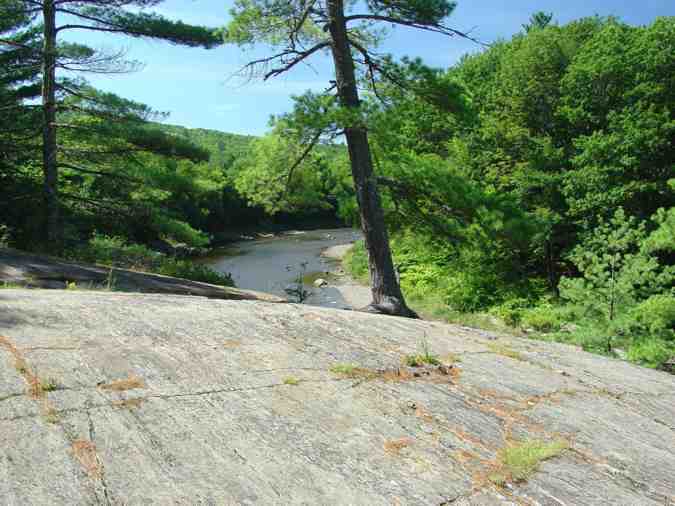|
Overview
Along the Sandy River in Strong Maine is a large outcrop of meta-sedimentary rock with narrow bands of instrusive white quartz. The outcrop overlooks the river and provides a picturesque view of the river which is suitable for outdoor picnics, boating and fishing. The popularity of this location is attested to by the hundreds of names carved into the rock’s surface from the 1860’s through the 1930’s. The bulk of the dates cluster in the 1877-1890 period. Several surnames are found repeatedly amongst the names an appear to date from different years suggesting that multiple generations of the same family visited the location over time. The house carving depicts what could be either a small farm house or a seasonal camp. One inscription is inscribed “Lewiston ME” suggesting that at least some of the visitors were within a day’s travel of the rock.
The inscriptions show the full range of carving techniques in use in the late 19th century. Some are straight foward basic block lettering, others are carved in relief, some have the rock surface smoothed (prepared), and the most intrique are inscriptions carved in fancy scripts by professionally trained carvers (possible gravestone carvers, immigrant stone carvers, or stone masons?). All of the inscriptions were carver with metal chisels. These chisels would had to been carried to location for this express purpose.
Strong was served by a narrow guage railroad line which originated in Farmington, Maine and had branch lines to Kingfield, Phillips, and the Rangeley Lakes area. The rail lines operated between 1879 and 1935/36. In the early 20th century the various lines were merged into the Sandy River and Rangeley Lakes RR. The principle business of the RR was hauling freight for various lumber related mills and providing passenger service for tourists visiting the region. In the 1890’s, the RR operate three round trip passenger trains between Farmington and the Rangeley Lakes for tourists.(For more information www.srrl-rr.org)
The dated inscriptions for the most part coincide with the years of operation of the RR. The working hypothesis is the inscriptions were carved by men working on the RR and/or related lumber industries and by tourists. The inscription rock was within easy walking distance of Strong RR station. The RR would have employed stone masons and other skilled labor to built bridge abutments / piers, stone culverts, etc for the rail line. This could account for the unusual highly skilled workmanship of some of the inscriptions. The location was ideal for various outdoor activities would have been attractive to tourists.
Special thanks to Judy and Dave Byrant of the Ancients Ones of Maine (living history group) for bringing this site to our attention. The exact location of the site has been withheld to protect it from vandalism. Qualified historians or researchers should contact us directly for further information about the site including exact location.
|







